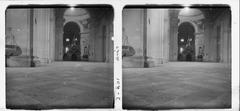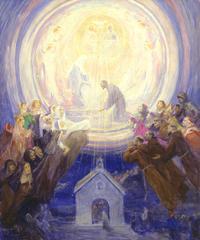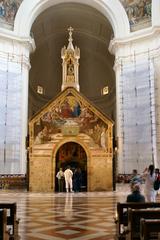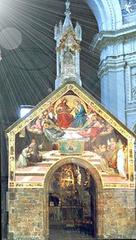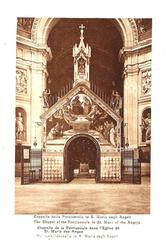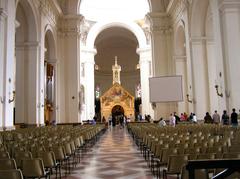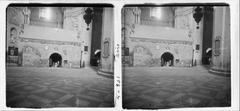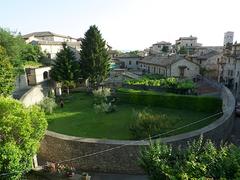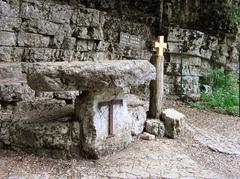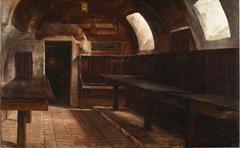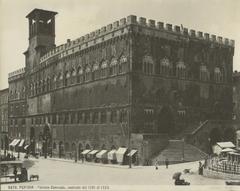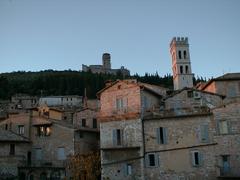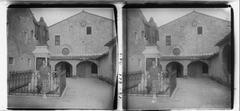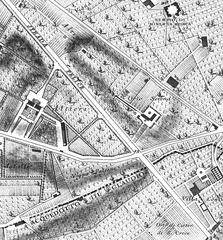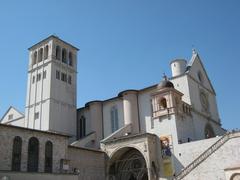
Portiuncula Assisi Italy: Visiting Hours, Tickets, and Travel Guide
Date: 14/06/2025
Introduction
Nestled in the tranquil town of Santa Maria degli Angeli, just 4 kilometers from Assisi’s historic center, the Portiuncula Chapel—also known as Porziuncola or “little portion”—is a cornerstone of Christian heritage and Franciscan spirituality. As the site where Saint Francis of Assisi founded the Order of Friars Minor and where Saint Clare began her religious journey, the Portiuncula is revered by pilgrims and history enthusiasts alike. The chapel is also the epicenter of the “Pardon of Assisi,” a plenary indulgence that continues to draw visitors worldwide, especially during the feast on August 2nd.
This comprehensive guide covers the historical significance of the Portiuncula, practical visitor information—such as visiting hours and ticketing—accessibility, travel tips, and highlights of nearby attractions in Assisi. Whether you are seeking spiritual renewal, historical context, or cultural enrichment, this article will help you plan a memorable visit to one of Italy’s most cherished sacred sites (Catholic Encyclopedia; Trek Zone; Italia.it).
Table of Contents
- Historical Background
- Visitor Information
- Nearby Attractions in Assisi
- Visitor Experience and Tips
- Frequently Asked Questions (FAQ)
- Conclusion
- References and Useful Links
Historical Background
Origins and Early History
The Portiuncula’s origins are rooted in early Christian tradition, possibly dating back to the 4th century, when hermits from Palestine are believed to have built the original oratory and dedicated it to the Virgin Mary. By the 6th century, the land and chapel were entrusted to the Benedictines, hence its name “Portiuncula,” meaning “little portion” (Roman Catholic Saints). Over centuries, neglect led to its ruin until the late 12th century (Encyclopedia.com).
St. Francis of Assisi and the Portiuncula
The Portiuncula is inextricably linked to St. Francis of Assisi. In 1207, following his conversion, Francis restored the chapel, drawn by its simplicity and spirit of poverty. He founded the Order of Friars Minor here, and the Benedictines formally granted the use of the chapel to Francis and his followers around 1211 (Catholic Encyclopedia). The Portiuncula also marks the spot where St. Clare received her habit and the first general chapters of the Franciscan Order were held (Centenari Francescani).
The Portiuncula Indulgence (“Pardon of Assisi”)
In 1216, St. Francis experienced a vision at the Portiuncula, requesting from Pope Honorius III a plenary indulgence for those who visited the chapel, confessed, repented, and prayed for the Pope’s intentions. This indulgence, originally limited to August 2nd, is now extended to any day at Franciscan churches worldwide, though August 2nd remains a key pilgrimage date (Secret Umbria; John P. Walsh Blog).
Architectural Features and Artistic Heritage
The Portiuncula is a humble Romanesque stone chapel, measuring about 5.5 by 3.2 meters, with a single nave and a saddle roof (Wikipedia). The façade is adorned with an 1829 fresco by Johann Friedrich Overbeck, and the interior features a late 14th-century polyptych and a Crucifixion fragment by Perugino. To safeguard this sacred space, Pope Pius V ordered the construction of the grand Basilica of Santa Maria degli Angeli (1569–1679), which now encases the chapel and includes the Chapel of the Transit, the place of St. Francis’s death (Secret Umbria; Encyclopedia.com).
Visitor Information
Visiting Hours and Tickets
- Opening Hours: Daily from 7:00 AM to 7:00 PM. Hours may vary during religious events or holidays; always check the official basilica website for updates.
- Tickets and Fees: Admission to the Portiuncula and Basilica of Santa Maria degli Angeli is free. Donations are appreciated and help support ongoing maintenance.
- Guided Tours: Local operators and the basilica offer guided tours in multiple languages. Booking in advance is recommended during peak seasons.
Accessibility
The basilica and Portiuncula are wheelchair accessible, with ramps and paved pathways. Assistance is available on request; contact the basilica administration before your visit if you have specific needs (Italia.it).
How to Get There
- Location: Piazza Porziuncola, 1, 06081 Assisi PG, Italy, in Santa Maria degli Angeli, 4 km from Assisi’s medieval center.
- By Train: The Assisi train station is a 10-minute walk from the basilica, with frequent connections from Rome, Florence, and Perugia (The Catholic Travel Guide).
- By Bus: Local buses run between Assisi’s upper town and Santa Maria degli Angeli.
- By Car: Ample parking is available near the basilica.
- On Foot or Bike: For active visitors, scenic walking and cycling routes connect Assisi’s upper and lower towns.
Best Times to Visit
- Early Morning or Late Afternoon: These hours offer a quieter, more contemplative experience.
- Avoid Major Feast Days: The Feast of Our Lady of the Angels (August 2) and the Feast of St. Francis (October 4) attract large crowds.
- Dress Code: Modest clothing is required; shoulders and knees should be covered.
Nearby Attractions in Assisi
- Basilica di San Francesco: Assisi’s most renowned church, a UNESCO site adorned with frescoes by Giotto and Cimabue.
- Rocca Maggiore Fortress: Offering panoramic views and a glimpse into Assisi’s medieval military past.
- Convento di San Damiano: The site of St. Francis’s calling and St. Clare’s convent.
- Roman Forum and Archaeological Museum: Showcasing Assisi’s Roman heritage beneath the main piazza.
- Cathedral of San Rufino: The baptism site of St. Francis and St. Clare.
- Le Carceri Hermitage: A tranquil retreat in the woods of Monte Subasio.
- Piazza del Comune: The lively civic heart of Assisi with Roman and medieval landmarks.
For day trips, consider exploring Spello, Montefalco, Gubbio, and Perugia.
Visitor Experience and Tips
- Photography: Allowed in the basilica but not inside the Portiuncula chapel itself. No flash or tripods.
- Facilities: Includes restrooms, a gift shop, and a café.
- Guided Tours: Enhance understanding of the chapel’s history and art.
- Accessibility: The basilica is fully accessible, but some historic sites in upper Assisi may be challenging for those with mobility issues.
- Crowds: To avoid the busiest times, visit early or late in the day and avoid major feast days (Friars US).
Frequently Asked Questions (FAQ)
Q: Do I need a ticket to visit the Portiuncula?
A: No, entry is free for all visitors. Donations are welcome.
Q: What are the visiting hours?
A: Generally, 7:00 AM to 7:00 PM daily. Confirm on the official basilica website before your visit.
Q: Is the Portiuncula wheelchair accessible?
A: Yes, the basilica and chapel provide ramps and accessible paths.
Q: Can I take photographs inside the Portiuncula?
A: No photography is allowed inside the chapel itself; photography is permitted in the basilica, excluding flash and tripods.
Q: When is the best time to visit?
A: Early mornings or late afternoons are least crowded. Avoid major feast days for a quieter experience.
Q: How do I get from Assisi’s center to the Portiuncula?
A: Walk, take a local bus, taxi, or drive to Santa Maria degli Angeli (4 km from Assisi center).
Conclusion
The Portiuncula Chapel, enshrined within the Basilica of Santa Maria degli Angeli, stands as a testament to the enduring legacy of Saint Francis and the birth of the Franciscan movement. Its humble architecture, profound spiritual history, and remarkable accessibility make it a must-visit for anyone exploring Assisi or the broader region of Umbria. Coupled with Assisi’s array of historical sites and scenic day trips, the Portiuncula offers a unique opportunity to experience Italy’s spiritual and cultural heart.
To maximize your experience, plan your visit outside peak pilgrimage times, dress modestly, and consider a guided tour for deeper insight. For the latest updates, special events, and travel assistance, consult official resources and consider using the Audiala app for audio guides and travel tips.
Embrace the peace and inspiration found at the Portiuncula, and let your journey through Assisi enrich your understanding of Italy’s religious, artistic, and cultural tapestry.
References and Useful Links
- Catholic Encyclopedia
- Trek Zone
- Italia.it
- Roman Catholic Saints
- Encyclopedia.com
- Secret Umbria
- Centenari Francescani
- John P. Walsh Blog
- Wikipedia
- The Catholic Travel Guide
- Friars US
- Indian Catholic Matters
- Vagrants of the World
- Go Ask a Local
- Travel to Italy Guide
- Savoring Italy
Official Websites:
